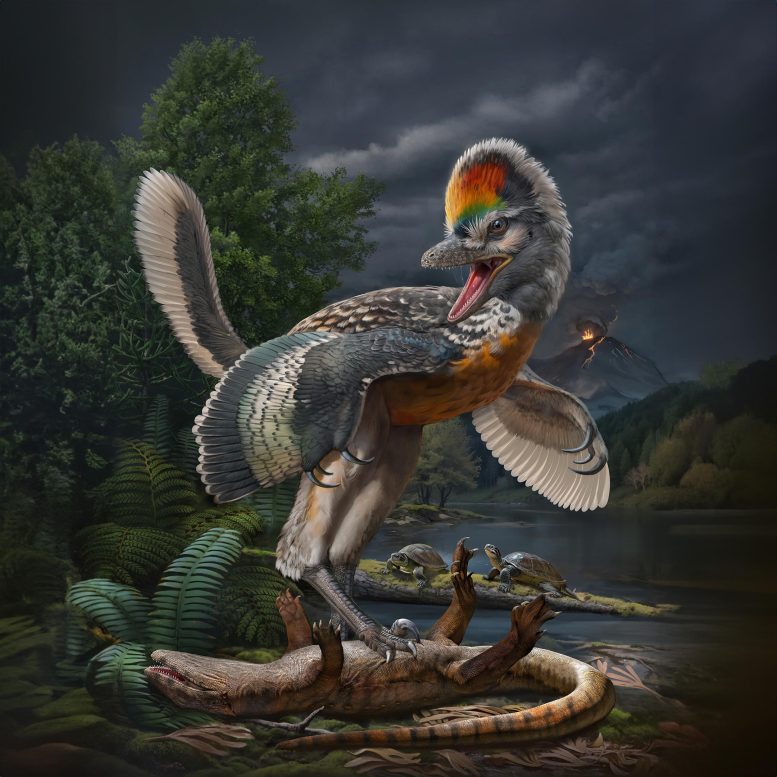
Life reconstruction of the 150-million-year-old avialan theropod Fujianvenator prodigiosus. Credit: Chuang Zhao
A new 150-million-year-old avialan theropod, Fujianvenator prodigiosus, has been discovered in China, offering fresh insights into early bird evolution and the Late Jurassic terrestrial ecosystem.
Birds descended from theropod dinosaurs by the Late Jurassic, but our understanding of the earliest evolution of the Avialae, the clade comprising all modern birds but not Deinonychus or Troodon, has been hampered by a limited diversity of fossils from the Jurassic. (A clade is a group of organisms that consists of a single common ancestor and all its lineal descendants, representing a single branch on the “tree of life.”)
As of now, no definitive avialans have been reported except the Middle–Late Jurassic Yanliao Biota in northeast China (166–159 million years ago; Ma) and the slightly younger German Solnhofen Limestones, which preserve Archaeopteryx. Consequently, there is a gap of about 30 million years before the oldest known record of Cretaceous birds. However, the Jurassic avialans are key to deciphering the evolutionary origin of the characteristic avialan body plan. More importantly, they are key to reconciling the phylogenetic controversy about the origin of birds.
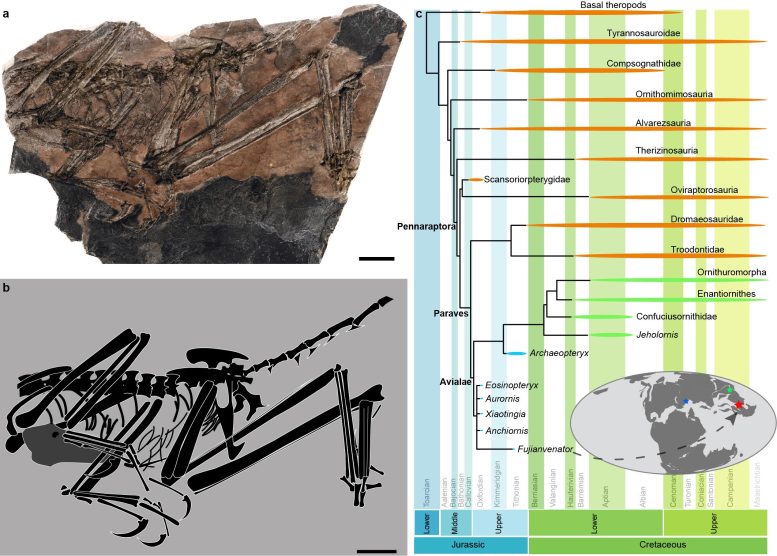
Photograph and interpretive line drawing of the 150-million-year-old avialan theropod Fujianvenator prodigiosus, with a phylogeny and paleomap showing the locality of the Zhenghe Fauna (red star). Credit: Min Wang
A New Discovery
A joint research team from the Institute of Vertebrate Paleontology and Paleoanthropology (IVPP) of the Chinese Academy of Sciences in Beijing and the Fujian Institute of Geological Survey (FIGS) described and analyzed a new 150-million-year-old avialan theropod from Zhenghe County, Fujian Province.
The findings were published in Nature on September 6.
The new species, named Fujianvenator prodigiosus, exhibits a bizarre assembly of morphologies that are shared with other avialans, troodontids, and dromaeosaurids, showing the impact of evolutionary mosaicism in early bird evolution.
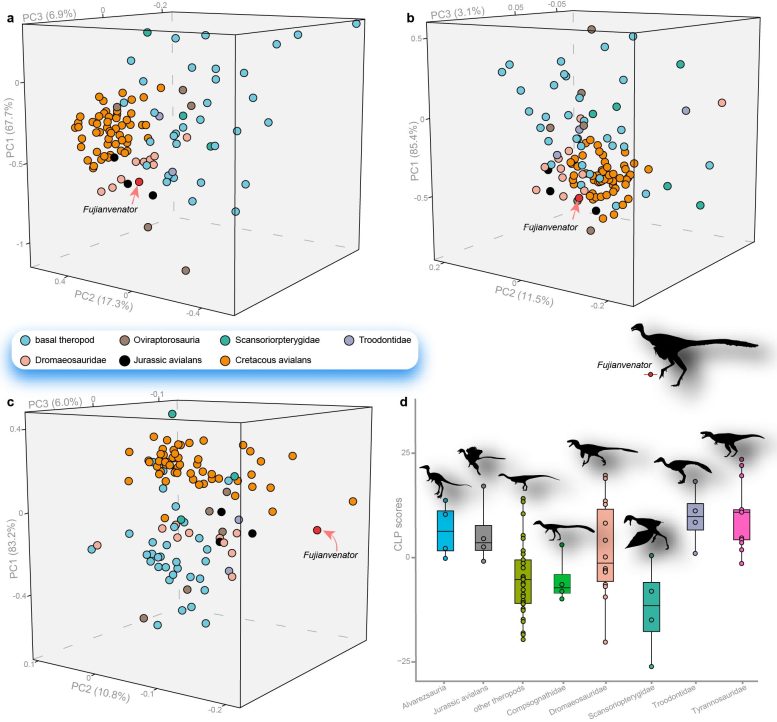
Morphometric space of body plan and cursoriality of Fujianvenator prodigiosus, compared with other Mesozoic theropods. Credit: Min Wang
Fujianvenator’s Unique Morphology
“Our comparative analyses show that marked changes in body plan occurred along the early avialan line, which is largely driven by the forelimb, eventually giving rise to the typical bird limb proportion,” said Dr. Min Wang from IVPP, lead and corresponding author of the study. “However, Fujianvenator is an odd species that diverged from this main trajectory and evolved bizarre hindlimb architecture.”
The surprisingly elongated lower leg and other morphologies, in combination with other geological observations, suggest that Fujianvenator lived in a swamp-like environment and was a high-speed runner or a long-legged wader, representing a previously unknown ecology for early avialans.
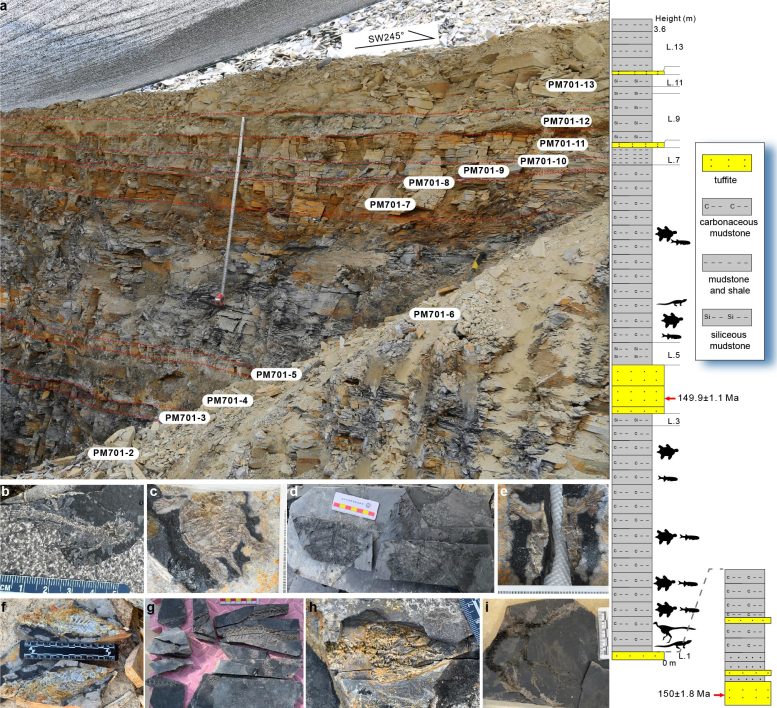
Stratigraphic log and vertebrate fossil assemblage discovered in the Late Jurassic Zhenghe Fauna. Credit: Min Wang
Geological Context and Implications
“Besides Fujianvenator, we have found abundant other vertebrates, including teleosts, testudines, and choristoderes,” said Liming Xu from FIGS, lead author of the study.
During the Late Jurassic–Early Cretaceous, southeastern China underwent intensive tectonic activities due to subduction of the paleo-Pacific plate, resulting in widespread magmatism and coeval fault-depression basins, where Fujianvenator was found. This geological background is essentially the same as in the Late Jurassic in north and northeastern China, where the older Yanliao Biota is preserved.
“The extraordinary diversity, unique vertebrate composition, and paleoenvironment strongly indicate that this locality documents a terrestrial fauna, which we named the Zhenghe Fauna,” said Dr. Zhonghe Zhou from IVPP, co-author of the study. In-situ radioisotopic dating and stratigraphic surveys constrain the Zhenghe Fauna to the period from 150–148 Ma. Therefore, Fujianvenator documents one of the stratigraphically youngest and geographically southernmost members of the Jurassic avialans.
The discovery of the Zhenghe Fauna opens a new window into the Late Jurassic terrestrial ecosystem of the planet, and the joint research team from IVPP and FIGS plan to continue their exploration of Zhenghe and nearby areas.
Reference: “A new avialan theropod from an emerging Jurassic terrestrial fauna” by Liming Xu, Min Wang, Runsheng Chen, Liping Dong, Min Lin, Xing Xu, Jianrong Tang, Hailu You, Guowu Zhou, Linchang Wang, Wenxing He, Yujuan Li, Chi Zhang and Zhonghe Zhou, 6 September 2023, Nature.
DOI: 10.1038/s41586-023-06513-7

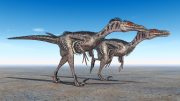
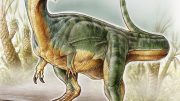
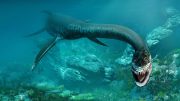
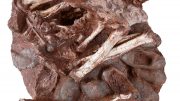
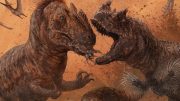
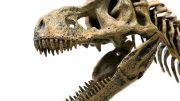
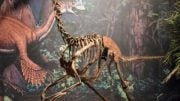
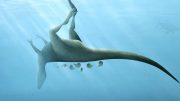
If birds are dinosaur prove it challenge a bandit scientist whit my view in a fair debate .dinosaur is not a bird only dinosaur alive the gator is nothing like bird is more like a turtle .anchoirnithae is a troodon it has bird hip troodon has lizard hip but not dinosaur size or have unique pubis hip like dinosaur they do not have dinosaur hip.these flightless bird like velociraptor do not have grasping finger claws they have tree climbing claws because they flightless .anchiornithae wings size is like modern birds for flight this fossil is a anchiornithae .
The proof is the phylogenetic tree shown in the article.
The larger evolutionary relationships with alligators and turtles goes like this [“Reptile”, Wikipedia]:
Lepidosauria (lepidosaurs)
Rhynchocephalia (tuatara and relatives)
Squamata (lizards, snakes and amphisbaenians)
Archelosauria
Testudines (turtles)
Archosauria (archosaurs)
Crocodilia (crocodilians)
Dinosauria (dinosaurs)
Aves (birds)
Comment box editor removes leading spaces. Let’s try hyphens:
Lepidosauria (lepidosaurs)
-Rhynchocephalia (tuatara and relatives)
-Squamata (lizards, snakes and amphisbaenians)
Archelosauria
-Testudines (turtles)
-Archosauria (archosaurs)
-Crocodilia (crocodilians)
–Dinosauria (dinosaurs)
Aves (birds)
Sigh. I missed Aves:
Lepidosauria (lepidosaurs)
-Rhynchocephalia (tuatara and relatives)
-Squamata (lizards, snakes and amphisbaenians)
Archelosauria
-Testudines (turtles)
-Archosauria (archosaurs)
–Crocodilia (crocodilians)
–Dinosauria (dinosaurs)
—Aves (birds)
Clearer now?
The fossil is anchoirnithae .the paleo art did a good job the knee pointed back of nose the v shape knee a classic bird feature because this fossil is a bird .dinosaur knee is in front of nose like human like most animal this feature is slow feature bird knee is fast feature like horse they have elongated ankle that look like tibia .dinosaur knee between tibia and femur the bird knee and horse between ankle and tibia
Rahonavis a dromaeosaur the wing is size of archaeopteryx and modern birds I thought only archaeopteryx type early birds had wing that size